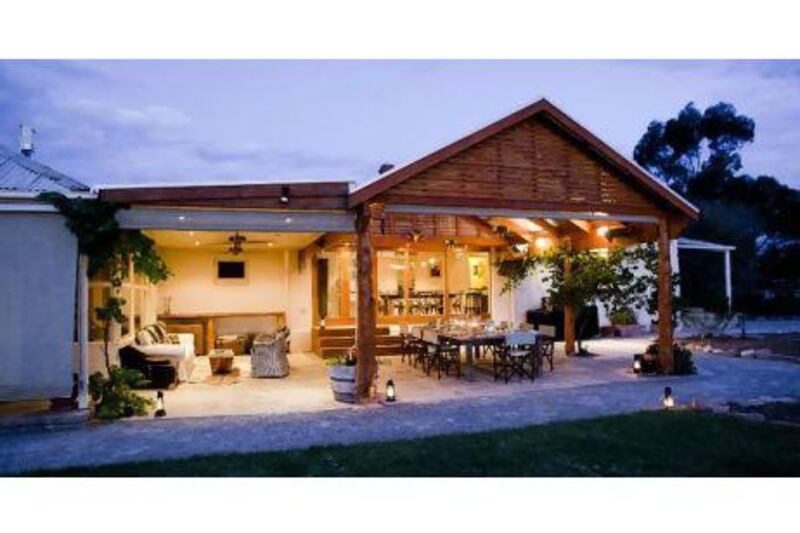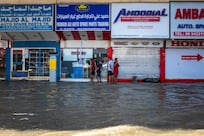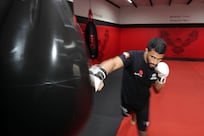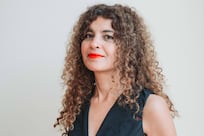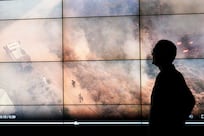For many - Australians as well as visitors - the outback evokes a flat landscape with vistas of red dirt stretching to the horizon. But there is more to central Australia than that, and the Flinders Ranges, with their gorges, peaks and escarpments, and colours that shift incessantly as the day progresses, prove the point.
Arkaba is a historic sheep station dating to the 1850s, consisting of 24,000 hectares of land and a recently renovated homestead. The latter - which has an authentically rustic feel to it, with meals served on a former wool-grading table and animal-skin rugs scattered liberally - accommodates only 10 guests, so the atmosphere is intimate and the service highly personalised. There is a library, shady terraces and a swimming pool in which you can loll while admiring the views.
After being greeted with cool towels and glasses of ginger beer, we set out to explore the station - still a working sheep ranch - with the resident guide, Kat Mee, who, despite having arrived in Australia relatively recently from her native Scotland, was formidably knowledgeable about the area.
The undulating scenery looks particularly lovely in the late afternoon, as we discovered during a walk through a dry creekbed fringed with river red gum trees and a drive along a ridgetop in the shadow of the Elder mountain range, which marks one extremity of the sprawling property. Kat alerted us to the diverse birdlife - galahs, corellas, kestrels and vividly coloured ringneck parrots - and also explained the difference between a kangaroo and a wallaroo, or euro. (The latter hops faster and in a more upright posture.)
We spotted a pair of emus wandering through the bush, and a female western grey kangaroo with a "joey" (baby) in her pouch. Then it was back to the homestead for dinner - watermelon soup followed by braised beef cheek with polenta, pumpkin and swede - and a good night's sleep in the neat and comfortable rooms.
The next morning, we got up at dawn to climb the 450-metre-high Arkaba Hill, which required a steep scramble up sheep tracks but rewarded us with a tableau of shimmering ochres and greens that spread out before us as the sun ascended. From on high we could see another set of mountains, the Chase range, and the tiny hamlet of Hawker, a 20-minute drive away. I was struck by the picturesque names for the local vegetation: saffron thistle, elegant wattle, caterpillar weed, velvet potato bush.
Relics of Arkaba's history, including old shearing sheds, lie dotted around the property, which is just south of Wilpena Pound, the best-known destination in the Flinders. While Wilpena can be crowded, you won't see another soul at Arkaba apart from fellow guests and homestead staff - and, consequently, as Brendon Bevan, the station manager, puts it, "you can really plug into the wilderness surroundings". At the same time, you're getting a taste of outback living, albeit with a distinctly luxurious flavour.
If Arkaba, situated around 400 kilometres north of Adelaide, feels like it's in the middle of nowhere, the Louise, which is in one of Australia's main wine-growing areas, the Barossa, is barely an hour from the city. The Barossa was settled in the 1840s by Prussians who had emigrated in search of religious freedom; they cleared land for farming and established communities complete with Lutheran churches. Many of the original buildings are preserved in towns such as Tanunda, while the hamlet of Bethany has 160-year-old cottages identical to those left behind by the settlers in Silesia.
The German influence is still visible, and not only in the architecture. Salamis and other cured meats are on sale at the weekly farmers market near the town of Angaston. In Lyndoch, a 30-year- old Bavarian cafe that serves German meals. Maggie Beer, a pioneering champion of Australian regional food, sells her produce from a farm shop in Nuriootpa. The Barossa also has a strong artistic tradition, and there are many galleries, craft outlets and artists's studios to visit.
The lodge itself is an elegant, up-market retreat set in landscaped grounds, and attracts a sophisticated crowd. My suite, one of only 15, has muted furnishings, a private terrace and outdoor walled shower. A discreet notice on the coffee table warned there might be Portuguese millipedes around - this is a pest that invades southern Australia during autumn and spring. Scanning the room, I noticed a few of the squirming black creatures, but thought nothing much of it.
The Barossa is known for its excellent produce - including cheeses, olives, pickles, breads and chutneys - and the Louise's restaurant, Appellation, has won numerous awards, so I was looking forward to dinner. It proved a memorable experience; I can still taste the smoked kingfish with salsa mayonnaise and hazelnut salsa, the salad of roasted sweet potato, and the South Australian snapper with sauteed zucchini and pilaf. At the end of the evening, we met the man behind it all, Mark McNamara, Appellation's gregarious executive chef, who had just finished his shift in the kitchen. McNamara talked to us about the Barossa's excellent produce and showed us his extensive vegetable garden in the Louise's grounds.
Returning to my suite quite late and with an extremely full stomach, I found the place swarming with millipedes. They were all over the carpet, on the walls, in the bathroom, even on the ceiling. I called reception; soon afterwards, a man arrived with a vacuum cleaner and sucked up as many of the creatures as he could, but as he left, more of them were streaming in under the front door. I had a rather fitful night's sleep, and it wasn't the fault of The Louise; the millipedes are virtually impossible to control, as apologetic reception staff explained. My suite was located a little further into the bush than others, so my fellow guests did not receive quite as many unwelcome visitors.
Kangaroo Island, off the southern coast of Australia is a nature-lover's paradise known for its beautiful, wild beaches and its profusion of native wildlife. Tourists who spend weeks fruitlessly scouring the mainland for kangaroos and koalas always see plenty on the island, along with penguins, wallabies, sea lions and fur seals and, possibly, goannas and echidnas.
I had visited Kangaroo Island years earlier; since then, the Southern Ocean Lodge had been built, and it had received such rave reviews - not to mention multiple awards - that I was slightly nervous in case it was a let-down. It did not disappoint. From the moment we stepped into the "Great Room", an enormous, amphitheatre-like space with floor-to-ceiling windows overlooking the Southern Ocean, I felt like a film star. And had I been one, I wouldn't have been out of place. The lodge has become a popular haunt of celebrities and royalty, and I was told that recent visitors included Sheikh Mohammed bin Zayed Al Nahyan, the Crown Prince of Abu Dhabi.
After the Great Room, the next sensation was the suites - 21 of them are strung along a clifftop, and all have heart-stopping views not only of the surf but also of the pristine wilderness surrounding the lodge. One of my travel companions instantly declared that he would be staying put in his suite, with its glass-walled bathroom, sunken lounge and local artwork. I knew how he felt, but something drew me back to the Great Room, which contains the restaurant, bar and several lounge areas. That something was a heated plunge pool on an outdoor terrace; I spent a good couple of hours lounging in the pool and gazing out to sea.
The next day, I got up early to go walking. (There are guided walks, but you can just as easily strike out on your own.) Heading west, I reached a settlement called Hanson Bay, after dipping in and out of little inlets and beaches. Returning to the lodge, I then walked in the other direction, along a marked clifftop path from which you sometimes see pods of dolphins. En route, in a secluded spot, is Southern Ocean's spa, which doles out terrific massages.
One-third of Kangaroo Island is a national park, and the wildlife is so abundant that the place is sometimes dubbed Australia's Galapagos, or a "zoo without fences". An island tour is included in the lodge's nightly tariff. We did a slightly rushed version of it, which took us to Admirals Arch, a jagged rock formation overhanging a colony of New Zealand fur seals, and Remarkable Rocks, a collection of enormous, multi-hued boulders eroded over the millennia into unusual shapes.
Like Southern Ocean Lodge, Saffire Freycinet resort in Tasmania (on the cover) blends cleverly into its environment, and is almost invisible until you get up close. Saffire opened last year on the Freycinet Peninsula, a couple of hours' drive north of Hobart and one of the places I love best in all Australia. Oyster Bay, on the shores of which the lodge is situated, is a large, serene cove, while nearby is Wineglass Bay, a perfect arc of white sand often cited as one of the world's best beaches.
There is no shortage of high-quality places to stay in the area, but Saffire is in a class of its own. The 20 timber-panelled suites - ranged in a wavy line to evoke waves breaking on the shore - are exquisite, the food is fantastic and the service blends attentiveness with relaxed informality. Arriving alone (this was a separate trip), I felt swept up in a warm but respectful embrace, with the friendliness of the staff matched by that of other guests, mostly well-dressed couples from Sydney and Melbourne.
Saffire has a grand entrance that is approached via a jetty-like walkway flanked by quietly babbling waterfalls and rose-hued marble. The water and the marble are intended to evoke the natural surroundings: Oyster Bay and, towering over it, three pink granite mountains called the Hazards.
I had climbed one of the Hazards, Mount Amos, on a previous visit to Freycinet, and found it quite gruelling. So this time I decided to take things relatively easy. Borrowing one of the lodge's mountain bikes, I made the short trip into Coles Bay, the little township nearby, and then explored some of the fire trails in the Freycinet National Park. At dinner, I enjoyed local seafood prepared by the head chef, Hugh Whitehouse, who was poached by Saffire from an award-winning restaurant in the Blue Mountains, west of Sydney.
Back in my suite, I had a long soak in the oversized bathroom overlooking the water. Then, deciding that rest was overrated, I left the electronically operated blinds open overnight, waking with the sun to the blissful views. After a wander on Muirs Beach, next to the lodge, I managed to tear myself away from Saffire. I walked to Wineglass Bay (a return trip of about three hours) and, before leaving the area, made a stop at Honeymoon Bay, a gorgeous spot where you can go kayaking.
Wineglass Bay, so named because of its curve, and not accessible by road, is the high point of a visit to Freycinet. Although the sea is usually too cold for a swim, the beach - which is frequented by tame wallabies - is a good place for a bracing stroll. It is also possible, rather than retracing your steps back to the start of the walk, to continue in a loop that takes you through bushland and back along the coast. The whole trip takes about five hours, but is worth the effort - and afterwards you have that big bathtub and another of Whitehouse's dinners to look forward to.
If you go
The flight
Return flights with Etihad Airways (www.etihadairways.com) from Abu Dhabi to Adelaide via Sydney cost from Dh8,195. Etihad Airways flies to Hobart via Melbourne from Dh8,065. Prices including taxes
The lodges
Double rooms at Southern Ocean Lodge (www.southernoceanlodge.com.au) start from A$2,670 (Dh10,294) per person for three nights, full board, with activities. Suites at the Louise cost from $429 (Dh1,654) per night, including breakfast. Double rooms at Arkaba Station (www.arkabastation.com) cost from $2,109 (Dh7,746) per night, full board, with guided activities. Suites at Saffire Freycinet (www.saffire-freycinet.com.au) cost from $1,450 (Dh5,326), excluding dinner but including $100 (Dh386) to spend at the spa. For more information on these properties, visit www.southaustralia.com.
